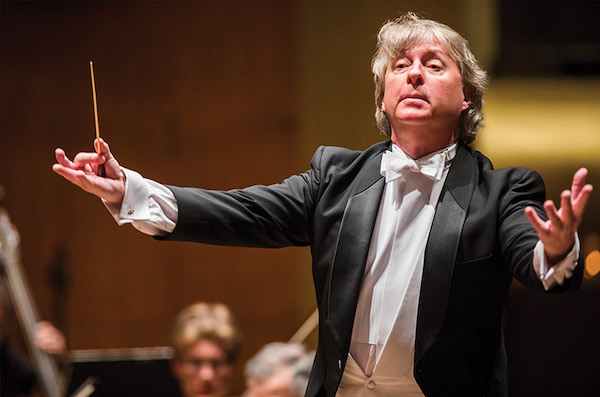American Classical Orchestra marks the Lenten season with Bach’s “Easter Oratorio”

Holy Week for Christians brings many musical observances, notably the dramatic Passions by J.S. Bach, which narrate, and meditate on, the events of Good Friday and the death of Jesus.
The 40-minute work that Bach compiled as his Easter Oratorio doesn’t match those mighty epics in scope and depth, but it contains much attractive and celebratory music, as demonstrated Tuesday night in Alice Tully Hall, when the American Classical Orchestra and Chorus performed it along with a favorite Bach motet, Jesu, meine Freude, BWV 227.
Performed under the overall title “Renew,” the two pieces offered contrasting responses to death and grief. Composed as funeral music, the motet carried a message of comfort, even defiance, despite the mournful character of its descending, minor-key chorale melody. The oratorio, bright with trumpets and timpani, declared victory over death at the empty tomb of Jesus.
Before leading his period-instrument ensemble in the motet, orchestra founder and artistic director Thomas Crawford offered a mini-lecture—a little hard to hear in Tully Hall without amplification—on how the music was put together. Players and singers illustrated on cue with snippets of their parts as Crawford explained concepts such as fugue, obbligato, and text-setting. It wasn’t long before impatience to hear some actual music set in.
When the motet finally got under way, the thought occurred that maybe the rehearsal time to prepare the talk would have been better spent cleaning up entrances and textures, so that all those subjects, countersubjects and motives could emerge clearly in the performance, not just the lecture.
The strings-and-continuo ensemble, following historical practice, doubled the vocal parts, adding their shiny timbre but not contributing much to attack or articulation.
Settings and elaborations of the chorale alternated with biblical texts in freer, more contrapuntal sections—although it would be hard for listeners to know that, since the latter were omitted from the printed “Texts and Translations,” leaving only the chorale stanzas. Texts for the oratorio were missing entirely from the program book. Whatever the reason—administrative snafu or budget constraints—following the words while listening to the music wasn’t an option at this concert.
The sound of the 14-member chorus–singing five vocal lines, SSATB—tended to feature a penetrating timbre in the Soprano I part. The reason became clear when soprano Chloe Holgate stepped forward to join a trio of soloists for the movement “Denn das Gesetz.” Though far from a non-vibrato early-music purist, Holgate wielded a clear straight tone that flexed and tapered beautifully, here and in her later solo in the oratorio.
If the movements of the motet could have used more rhythmic vitality to bring out their distinct character, trumpets and drums supplied plenty of that in the opening and closing movements of the Easter Oratorio. Baroque trumpeters Steven Marquart, John Thiessen, and Perry Sutton pealed out when called upon, and gave the ensemble a discreet brassy glint the rest of the time. Under the skillful sticks of Dan Haskins, the small Baroque timpani sounded rich, not thwacky.
Oboists Sarah Davol and Emily Ostrom gave a refreshing bite to the opening Sinfonia before throttling back to a mellow dance in the movement’s episode. Intonation problems occasionally bedeviled them in later movements, however.
The flauti dolci (recorders) of Nina Stern and Daphna Mor cast a dolcissimo spell over the blessed sleep of Peter in the aria “Sanfte soll mein Todeskummer,” though not without intonation issues of their own.
Following the Sinfonia and a keening Adagio with oboe solo, the “action” of the oratorio consists mainly of a scene-setting chorus with soloists, followed by very brief recitatives to introduce the two women and two disciples who meet at the empty tomb, before each of them reflects on the event in an aria.
Soprano Holgate sweetly shaped the meditation of Mary, the mother of James, on the soul’s triumph over death, as Keats Dieffenbach stood up from his concertmaster’s chair to play a silvery, ornate violin obbligato.
Floating on that cloud of dreamy recorders, Lawrence Jones’s clear but substantial tenor as Peter carried easily, as he imagined how blessed the sleep of death would be when he was wrapped in the shroud of Jesus.
Alto Helen Karloski depicted Mary Magdalene’s urgent search for Jesus in well-articulated running eighth notes and agreeably light, forward tone.
Although Bach didn’t grant him an aria, baritone Steven Eddy as John was stalwart in the recitatives, most notably the one (“Wir sind erfreut”) that introduced the work’s triumphant final chorus.
With economical gestures, conductor Crawford led a well-balanced and well-paced performance that could have used more of the transparency and rhythmic verve listeners have come to expect from period-instrument ensembles like this. But the opportunity to hear a lesser-known Bach work of the Lenten season is always welcome.
The American Classical Orchestra, conducted by Thomas Crawford, will perform “The Chaconne Project,” with mezzo-soprano Guadalupe Peraza, in music by Strozzi, Marais, Corelli, Bach, Couperin, Monteverdi, Purcell and others, 7 p.m. June 22 at Harlem Parish, 258 W. 118th Street. aconyc.org.